First off, if you’re experiencing the worst headache of your life, please stop reading and head to an emergency room, especially if it’s onset was sudden.
Alright, moving on:
I was thirteen, in English class and struggling to read. Don’t get me wrong, I knew how to read, but on this particular day, in this particular class, I couldn’t read at all. The center of my vision looked something like this:

“I’m going blind,” I thought, as I strained to read the blurred letters. I’m going fucking blind. I resigned myself to the fate, too embarrassed to raise my hand and ask to go to the nurse. What exactly would I say? That I’m going blind? No, can’t do that. And maybe it will get better, if I wait it out. Always a smart to wait things out when you’re convinced you’re becoming permanently disabled, right? So, instead of trying getting help, I just sat there and desperately hoped I wouldn’t get called on to read something.
When the period ended, I bee-lined it for the nurse’s office. On the way, as I imagined my new vision impaired life, and my head began to throb. The lights grew brighter, the next stage in going blind, I assumed.
“I’m going blind” I told her, expecting her face to fill with worry.
“What do you mean?” She said, not showing my anticipated level of concern.
“The middle of my vision is blurry, I can’t read.”
“Do you feel anything else? Do you have a headache?”
“Yes, my head hurts, because I’ve been straining trying to read.”
“Have you ever had a migraine before?”
“No.”
I hadn’t had a migraine before, and I didn’t know why she was so concerned with a fucking headache, while I was going fucking blind. She sat me in a dark room, and called my mom, who took me to the doctor’s. As I sat in the room, the pulsing pain became the worst headache I’d ever experienced.
The doctor confirmed the school nurse’s suspician, a migraine with aura. An aura is a symptom that can accompany the onset of some migraines or seizures. They range from the blurred distortions I experienced to more psychedelic distortions, like this artist’s depiction:

From wiki. Sorry about this jarring, headache-inducing image! If it bothers you, scroll down so it’s off the page.
My middle school migraine is so far the only one I’ve experienced. In fact for me, headaches in general pretty much disappeared in high school. Sometimes I wonder if it was just from getting older, from running track and cross country, or a habit that accompanied running–conscientiously drinking water throughout the day.
After college, a certain type of headaches came back for a while: caffeine withdrawal headaches. I found though, I only get them if I drink coffee immediately after waking up. I’ve switched my habit to drinking coffee after my morning commute, and even though I drink just as much caffeine, on days I skip the coffee, I’m tired and groggy, but the withdrawal headaches have gone away.
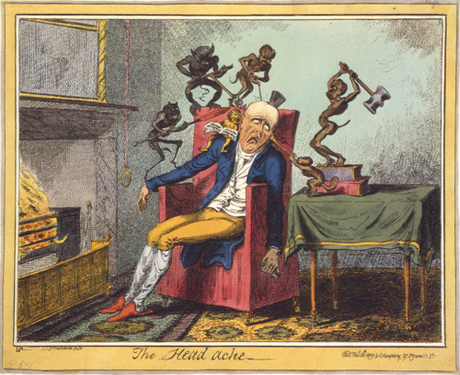
An 1819 caricature by George Cruikshank depicting a headache, via wiki.
The four main types of headaches
Now I want to shift away from anecdotes, and into the evidence. What are headaches?
Headaches may sound like minor inconveniences, but they cause more disability than any other neurologic problem.[1] In fact headaches are the most common health problems in the world, after cavities.[2]
Four main types of headaches are thought to account for up to 90% of all headaches:[3] migraines, tension headaches, cluster headaches, and chronic daily headaches.
1. Migraines – Migraines tend to only affect one side of the head, and cause moderate-to-severe pulsating pain lasting between four hours and three days. They can be preceded by an aura that can be visual, as I described above, or that can affect other senses, movement, or even language. Sometimes migraines can cause just the aura, and not the full headache. Also, migrates may cause nausea and vomiting.
Migraines can be brought on by certain triggers (though nocebo effects may be involved). Based on patient accounts, these are the top 10 most common migraine triggers:[4]
Trigger Percent reporting as trigger
1. Stress 79.7%
2. Hormones (in women) 65.1%
3. Not eating 57.3%
4. Weather 53.2%
5. Sleep Disturbance 49.8%
6. Perfume or odour 43.7%
7. Neck Pain 38.4%
8. Lights 38.1%
9. Alcohol 37.8%
10. Smoke 35.7%
Chronic migraines can be quite disabling, so sometimes patients take medications to try to prevent them. B-blockers (often used to treat hypertension) are also strongly recommended, as well as some tricyclic antidepressants, anti-seizure medications, and interestingly, commercially-produced proprietary herbal butterbur extract (though there are serious concerns that butterbur may contain other chemicals that are toxic to the liver). A different set of drugs is used to abort migraines, or treat their symptoms once they start.
The cause of isolated migraines without auras remains unknown, but we know a lot about migraines with auras.
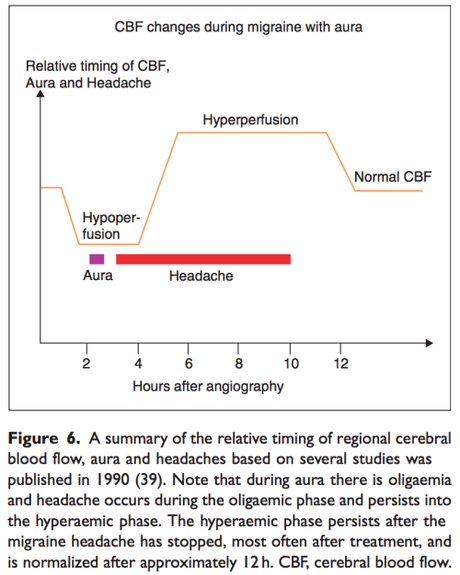
from Tfelt-Hansen, 2009
Migraines with auras are are associated with a decrease in blood flow in an area of the cortex that spreads outwards from that point, as well as a cortical spreading decrease in brain activity. Some migraines run in families, and therefore have genetic components. Most of the precise gentic links are unknown but mutations to sodium channels, calcium channels, and Na/K+ ATPase cause Familial hemiplegic migraine syndromes, which suggests that the level of neural excitability is important for these syndromes.[5]
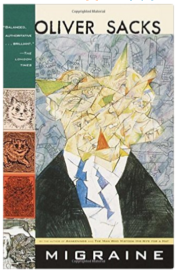
I haven’t read it yet, but Oliver Sachs devoted an entire book to the migraine. (See which of his books made their way onto the top five books about neuroscience that changed my life.)
2. Tension Headache – Tension headaches are probably what you think of when you think of a run of the mill headache. Every year, up to 65% of people will experience a tension headache,[6] with people in their 30s experiencing the most tension headaches.[7] They are mild or moderate, non-throbbing headaches, that usually respond to anti-inflammatory drugs like ibuprofen. However, be careful, many people who get tension headaches chronically (15 or more days per month) end up overusing these acute medications, which can make the problem worse in the long run.
It’s still unclear to what extent tension headaches are from pain in face and head muscles and to what extent they originate from pain-processing regions of the brain itself. Many neurologists now believe that the occasional isolated tension headache may be muscular in origin, whereas chronic tension headaches may originate from within the brain.[8]
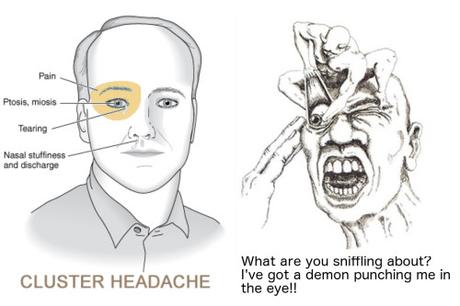
Two very different artist’s depictions of cluster headaches.
3. Cluster – Only one in a thousand people will get a cluster headache in their life,[9] with the average age for a first cluster headache at 31. Cluster headaches cause severe pain to one side of head for 15 minutes – 3 hours. They’re called cluster headaches because they occur in bursts, where a sufferer may get the headaches frequently for weeks and months, followed by months to a year without any attacks.
The severe headache may be accompanied by tearing, sweating, swelling, nose running, on the same side of the face that the headache is experienced.
Acutely, cluster headaches can respond to breathing 100% oxygen, and certain anti-migraine drugs. To prevent cluster headaches from occuring, verapimil, a calcium channel blocker is recommended.
The exact cause is unknown, but smoking is a risk factor, and there also appears to be some genetic component. While, the number of sufferers who have a direct relative with cluster headaches is only ~11%, that indicates much higher risk given that only .1% of the general population will experience a cluster headache in their lifetime.
Cluster headaches may involve over-activation of the opthalmic division of the trigeminal nerve, and may involve hypothalamic activity as well (some patients can even be treated through hypothalamic deep brain stimulation).[10]
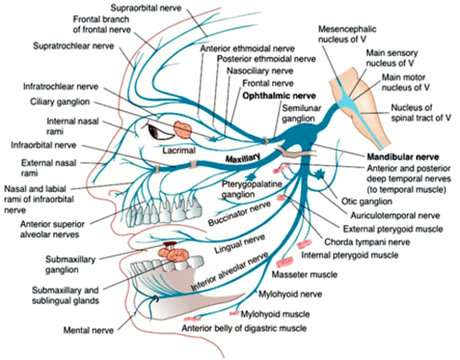
4. Chronic Daily Headache – By daily, they really mean every other day, this is a label given to people who experience 15 or more headaches per month. I say it’s a label, because this is more of a catch-all category, than it’s own specific disease, and in fact for example if you experience enough tension headaches each month they can be reclassified as chronic daily headaches.
Can you hurt your brain by thinking too much?
People often say that the brain is like a muscle, and while it’s true that many skills and memories are similar to muscles in that you need to ‘use them or lose them,’ the metaphor falls apart quickly after that. The brain itself doesn’t contain pain receptors, so a headache is not any indication that your brain is in pain (though the blood vessels and dura coating the brain contain pain detectors that can activate you if you brain is swollen or infected).
As far as we know you can’t damage your brain from thinking too much. Brain cells themselves become over active, that can damage them—a process called excitotoxicity— but this is only thought to occur in situations like epilepsy, drug abuse, or overstimulation by other dying cells. In fact there appears to be no change in the overall level of brain activity between someone concentrating full force and someone sitting idly and letting their mind wander.
But while over-thinking may not hurt your brain, over-thinking may make your head ache. As we saw above with migraines can be triggered by stress, not eating, and sleep disturbances, and tension headaches are also associated with stress, mental tension, or emotional disturbances. And working or studying too hard to an extreme may be counter-productive, as practices like meditation, which I think of as a kind of deliberate rest for many of your over-active brain circuits, has been shown to have lots of long-term benefits.
A final aside
There is one rare situation, where if you’re unlucky overuse of certain brain circuits may cause them to dysfunction: focal dystonia. This is a disease is sometimes called writer’s cramp, but most people don’t actually understand what writer’s cramp means, so that shorthand isn’t very useful. In this disease, ironically, the specific circuits for a motor skill that you spend years and years learning or using, becomes damaged.
From wikipedia: ”Focal dystonia most typically affects those who rely on fine motor skills (musicians, writers, surgeons, etc.). It is thought that the excessive motor training in these individuals may contribute to the development of dystonia as their cortical maps become enlarged and begin to overlap.[8] Focal dystonia is generally “task specific,” meaning that it is only problematic during certain activities.”
However, it is unclear if the overuse is actually causing some sort of real brain damage (such as a loss of neurons), or if rather, it results from a mis-wiring or aberrant activity within the existing circuit, for example that cortical map overlap mentioned in the wikipedia article.
If you liked this blog post and want to read more like it, please share it. If you didn’t like it, leave me some feedback. (Sometimes it feels like I’m just writing into a void.)
References (sorry, for the sloppy citation style, but the citations are legit):
[1] Harrison’s Internal Medicine, 19e, Chapter 21.
[2] The Global Burden of Disease survey 2010, Lifting The Burden and thinking outside-the-box on headache disorders http://www.l-t-b.org/assets/43/4F3BA7B2-DAF8-4C4B-A882874414B2341B_document/Outside_the_box.pdf
[3] http://www.uptodate.com/contents/evaluation-of-headache-in-adults
[4] The triggers or precipitants of the acute migraine attack http://onlinelibrary.wiley.com/doi/10.1111/j.1468-2982.2007.01303.x/full
[5] http://journals.sagepub.com/doi/pdf/10.1177/0333102413485658
[6] http://www.uptodate.com/contents/evaluation-of-headache-in-adults
[7] https://www.ncbi.nlm.nih.gov/pubmed/9459472?dopt=Abstract
[8] Tension-type headache: current research and clinical management – http://www.thelancet.com/journals/laneur/article/PIIS1474-4422(07)70325-3/abstract
[9] http://www.uptodate.com/contents/cluster-headache-epidemiology-clinical-features-and-diagnosis?source=see_link§ionName=EPIDEMIOLOGY&anchor=H3#H3
[10] Cluster headache: pathogenesis, diagnosis, and management. https://www.ncbi.nlm.nih.gov/pubmed/16139660?dopt=Abstract
Advertisements
